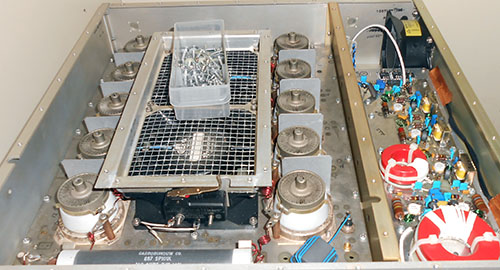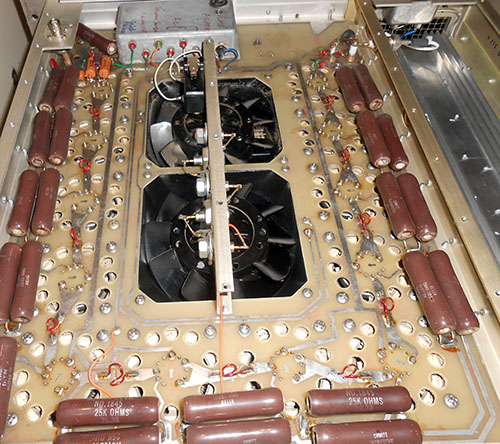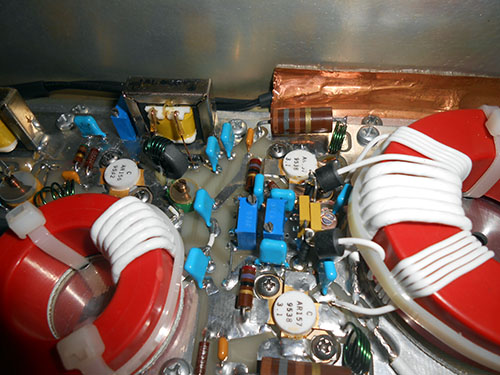The Ware for June 2021 is shown below.
This is, I think, the last from the Don Straney collection (thank you so much for helping to bridge me through the pandemic!). Maybe I’m showing a bit too much here to make it hard to guess, but, honestly, I had never seen the inside of one of these types of things before, and I probably never will in person; so I wanted to share more than less of its construction details. It’s kind of crazy what a rat’s nest it is on the inside; I particularly love the tiny loops of wire which I’m pretty sure are meant to serve as inductive elements, and not just jumpers.



Amplifier Research RF amplifier; probably 50W or more
Yeah, I think you’re right: https://www.eevblog.com/forum/rf-microwave/amplifier-research-50a220-rf-amp-teardown/
Reminds me of this crazy device from a few days ago: https://twitter.com/kenshirriff/status/1408899613331841024
The question is which one.. This Amplifier Research 1000LP – 1000 Watts pulse, 2-200MHz RF Amplifier might be a good candidate: https://www.ebay.com/itm/184724336276
Dang nailed it. I thought it was one of these https://www.axiomtest.com/Amplifiers-_-RF-and-Microwave/Above-1-GHz-and-100W-or-Less/Amplifier-Research/15S4G8A/Microwave-Amplifier%2C-4-_-8-GHz%2C-15W/
Agreed, although I think it’s the 1000LM20. The peak power of those 5CX250Bs (as pointed out by Mike) tubes should reach 2500W, and the front end looks like it’ll run up to 200MHz.
I assume those diodes on the bar across the fans are part of the HV crowbar. That microswitch would be the safety interlock for that panel.
Would like to know what the devices along side the fans are in the top photo. Power transistors? Monster amp ICs? Clearly with resistors the size of cigarette butts on board, there’s a lotta juice sloshing around.
Vacuum tubes. Air-cooled, ceramic vacuum tubes with finned cooling elements.
Looks like the RF pulse generator for some sort of electron accelerator like a LINAC.
I don’t know exactly what it is, but it has 10 vacuum tubes that look like 4CX250s. So that’s 2500 watts of plate dissipation. So it’s some kind of high power RF amplifier that’s capable of putting out somewhere between 2500 and 5000 watts, depending on the duty cycle.
The large toroids, and the number of turns on the toroids, suggests that it isn’t microwave. Also–10 tubes in parallel? Not microwave. Weird physical design, might be dictated by the form factor? 4CX250s aren’t very tall. I’d guess that the frequency is somewhere in the range of 15-30 MHz. So, what things require a high power RF generator in this range? MRI, some welding applications, maybe some kind of medical radiotherapy. I doubt it’s MRI–I don’t think they’d go for 10 tubes. I don’t think any form of radiotherapy uses that much power. So some kind of welding application?
An addendum, for a thought I didn’t complete. 10 tubes in parallel IS weird. You see crap like that on illegal citizen band amps and such. Lots of problems with imbalance between tubes, stray capacitance that is now in parallel, and so on. The only legit reason that I can imagine is that the low form factor is really, really important. 4CX250s are about 2 inches high; 8877s (a 1500 watt tube) are about 4 inches high. The designer really wanted this to fit into a cabinet as shallow as possible.
I don’t know if that helps, but it’s all I’ve got.
“frequency is somewhere in the range of 15-30 MHz. So, what things require a high power RF generator in this range?”
bouncing radio signals off the ionosphere to communicate with others doing the same thing, for fun!
Well, it’s got a bunch of valves whatever it has.
I love the honking great “carborundum co” resistor, it reminds me of the mock latin: “Illegitimi non carborundum” (don’t let the bastards wear you down).
I also immediately thought “4CX250B”. But no. Those are 11-pin tubes, which makes them something like 8122s which are 400W plate dissipation not 250W like the 4CX250B.
https://i.ebayimg.com/images/g/jlcAAOSwR9BfD5ua/s-l1600.jpg
Yup that looks like a match.
The 2xAR157 driver is mebbe good for 50W… so I’m going to guess this amplifier is good for about 4 to 5kW output. And yes it does look similar to the Amplifier Research stuff.
Also, no tuned circuits, so broadband.
And some weird fsckery with the cut traces and the two turn inductors between the grids of the differerent tubes which, if they are in fact 8122s, are running in parallel.
So yes, I’m still missing something. In what application would 12 (12, Mike, not 10 :-) parallel smaller tubes (with obvious stability issues) be better than one large tube?
And I’d nix the welder idea — you don’t need to carefully step up a signal through a bunch of transistors to drive the tubes for that — this circuit smells to me like it’s transmitting intelligence, which a welder doesn’t do.
And as Mike said, that’s all I’ve got.
One reason broadband amplifiers were never popular back in the vacuum-tube era is that tubes have a high output impedance (plate impedance), most loads are 50 or 75 ohms, and matching networks are inherently narrowband in nature.
One way to get the plate impedance down is to parallel a boatload of tubes. So that is likely the motivation here. That, and/or the need to minimize the number of rack units needed.
(I should say plate [i]resistance[/i] rather than plate impedance here, since AFAIK it’s always real.)
Definitely broadband, but it’s definitely an RF circuit, the telling factor being the snubber coils in the filament line. Otherwise, you’d get weird resonant effects and feedback via the filament circuit. Been ages, the 25k resistors look to be either 25 or 50 watts, I’m thinking 25 watt, so likely grid bias resistors.
I’m not seeing another grid, so these look like triodes,plates connected together and with the small inductors, UHF or microwave frequency operation.